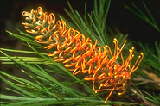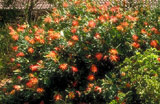|
[Front Page] [Features] [Departments] [SGAP Home Page] [Subscribe]

Southern Californian Experiences
Bill Grant
Friday, October 6, 1989, was a big day in this gardener's life. Travelling across Australia by van from Perth to Sydney, with many stops in the wild, our group of 18 American botanists, nurserymen and gardeners with Gwen and Rodger Elliot (1) as our guides, we visited Neil and Jane Marriott's garden (2). The display of Grevilleas took my breath away. I'd seen a lot in our UCSC garden, and I had cultivated over 50 myself. But nothing could match the display and beauty of this magnificent collection.
Our stop was far too brief, but it did give me a chance to photograph a large number of plants I had never seen before. I have titillated audiences ever since with these photos. To say nothing of myself.

Grevillea dryandroides in Neil And Jane Marriott's garden in Western Victoria. Select the thumbnail image or plant name for a higher resolution image (31k).
From that point I reached a new level of enthusiasm for these marvellous plants. And part of my life since has been devoted to them.
The Santa Cruz Arboretum
To go back a bit. Over a decade ago I first encountered grevilleas in an infant Arboretum on the campus of the University of California at Santa Cruz, newest in the chain of satellite colleges. Started by Dr Ray Collett and managed since then by Bret Hall, the Australian collection has steadily grown to be a magnificent garden that draws visitors all year. Artists, photographers, school groups, garden clubs, bird watchers - a steady stream in increasing numbers visit most days of the year. The UCSC Arboretum now has the largest collection of Australian natives outside their native land
Dominating the collection are the grevilleas, banksias, acacias, eucalypts and many more. As Rodger Elliot said on a recent visit, "They are slightly larger in size and blossom than their Australian relatives". Hall, Collett and others journey to Australia from time to time to study plants in the wild and return with cuttings and seeds to enlarge our list.
The facilities at the Arboretum are rather primitive by most standards. Plastic greenhouses and propagation areas stand near the only permanent building on the site. The first in a stage of structures was built with money raised by ten years of plant sales and donations. But the enthusiastic staff (one director, one manager, three part-time workers, students and volunteers) accomplishes a great deal with little money.
Grevillea Collections
Over the years the Grevillea collection has grown to be one of the largest in the Arboretum. Cuttings developed into one-gallon sale items bought by visitors as well as those offered at twice-yearly open houses and special events have enlarged the local audience for these plants. Grevilleas always sell out first. And we are hard pressed to keep up with the demand.
Rodger and Gwen Elliot have been our patron saints over the years. Many of the cuttings and seeds have come from their nursery and the trips staff members have made with them.
I am constantly pressing for more additions. This takes time and effort. But I am relentless in my urging. So far I have failed to get any cuttings of G. "Honey Gem", which I know would be a popular addition to California gardens. But I digress.

The honey-laden flowers of Grevillea "Honey Gem" are excellent for attracting birds. Select the thumbnail image or plant name for a higher resolution image (29k).
I have a half-acre garden on a hill with eucalypts, not far from the ocean. The summers are long and hot but rarely humid. We have over 300 days of sunshine a year. Our rainfall here can range from 11 inches to 45 (280 - 1150 mm). The Arboretum has nearly every kind of soil you can imagine, so they can experiment at will. Mine is either sandy or heavy red clay. I have amended a great deal of it with redwood chips, mushroom compost, rice hulls and my own compost. Basically acid, the soil had been leeched for over a hundred years by three kinds of eucalypts, what I call the weeds of that tree family. Nothing particularly pretty or restrained about them. They do, however, supply me with unlimited firewood. So most of the soil is without any nutriment whatsoever and is hostile to many plants.
I keep good records of the garden, and see that my first Grevillea was "Poorinda Constance" that came from a local nursery. In its twelfth year, it is regularly pruned to eight feet (2.5 metres) with a spread of about the same. It is vigorous. Inhabited throughout the year by several families of hummingbirds, it has cast some seedlings which bear great resemblance to the parent, though not completely. I am a poor judge so I will ask others to make a final judgement.
With that as a start, I purchased all the others from the Arboretum. With over 60 now in my collection, I feel the need to share my love and little expertise with others.
In most cases the grevilleas are incorporated into the regular garden. I grow a great many rose species as well as a big collection of old garden roses. Grevilleas are happy companions in this scheme. The latter bloom in many cases when the roses are dormant, thus giving me colour throughout the year. However, sometimes the flowering overlaps...for example G.rivularis in full bloom and festooned with arching sprays of R. "Aglaia", a hybrid multiflora rambler with hundreds of yellow blossoms. A happy pairing, G.rivularis has become the centrepiece of a perennial border and a nesting spot for birds.
G.oleoides (G.speciosa - Knight) and G."Red Glow" (actually from New Zealand nurseries) stand on both sides of a lovely native dogwood. I must add that we are the last to hear of name changes in this family and many plants at UCSC have had to he renamed for a variety of reasons. So please forgive the amateur. When any of you visit, please give us time to take you around to check on our collections.
G."Boongala Spinebill" has been a big hit in California for its varied use in gardens. My G."Canberra" grows in complete shade and is quite happy. G.juniperina sulphurea sprawls in a hot spot among Salvia and Pelargonium cordifolium. G."Ivanhoe" is making its way up between an Acacia and a Prostanthera mellisifolia. G.potybractea in full shade sits near G.dimorpha (fine leaf form) and G.dimorpha (narrow leaf form).
What we thought at first was G.hookeriana has turned out to be G."Red Hooks", Mine is 10 feet (3 metres) tall. G.barklyana sits near two banksias in the shade of two Coastal Oaks. I have four types of G.lavandulacea with "Penola" and "Tanunda" the outstanding plants in the garden. The latter is probably the most popular plant at the Arboretum sales.

Grevillea lavandulacea. This is the form from Tanunda in South Australia. Select the thumbnail image or plant name for a higher resolution image (27k).
Of course G."Robyn Gordon" is such a success in California that you will see it in many gardens. Grevilleas "Ivanhoe", "Clearview David", "Pink Pearl", "Red Glow" and many other hybrids are now making their way from the Arboretum to nurserymen and to the garden centres. I must say that the Poorinda hybrids have proved so hardy that their popularity has never waned. During a period of severe cold they remained untouched by any damage. In fact, my "Poorinda Constance" started blooming during the worst part of the January cold.

Grevillea "Ned Kelly" is very similar to G."Robyn Gordon". The latter has flowers of a deeper red. Select the thumbnail image or plant name for a higher resolution image (48k).
When the plants are sold at the University, we give written instructions with each variety. Plants sold in October at our big sale have a better chance of survival than those offered in our Spring festival. Young plants here survive most winters, but summer planting claims many new ones. Summer watering is the culprit. We constantly warn people about using any phosphorus fertilisers and I recommend pruning the more vigorous types once a year.
A few years ago I saw my first significant use of Grevilleas in public planting. A long driveway into a parking lot was lined with G.asplenifolia that reach about 6 feet (1.8 metres). They are planted quite close to one another. I realise now that I planted mine in the wrong place as the lovely arching limbs would grace any entrance way.
Reactions to Frost
The record freeze in 1991 in California immediately killed many annuals and perennials, both natives and outsiders. At Santa Cruz there was great damage to plants that lived in the wrong places. Identical plants that lived in full shade survived the 12-14 degree F temperatures (-11 - -10 degrees C), but others that were exposed to full sunshine during the daytime hours expired. These included banksias and grevilleas, as well as South African plants of a wide variety.
While we do not consciously test the frost-hardiness of most plants at the Arboretum, the freeze gave us this grim opportunity to do so. We can surmise that the sudden rise in temperature during the day literally "baked" the frozen plants and caused their deaths. Most of the blank places have been filled with replacements from our own stock or from Australia, mostly through the auspices of Gwen and Rodger Elliot.
In my own garden, I lost three newly planted grevilleas (a month before the freeze there had been a plant sale at the University), and strangely enough G.gaudichaudii died, though no one else, or the Arboretum, lost that one. And it grew in the shade!
Throughout the long freeze my (Grevillea) Poorinda hybrid "Constance" bloomed, saving the many humming birds from starvation. All the fuchsias and other nectar plants had perished. "Constance" was filled with the birds. Of course, it blooms longer and better than any of its kin in my garden.
Finally, the eucalyptus grove at the Arboretum has about forty different species. While the tips were frosted, no other damage was done. Strangely, when one walked under the trees at this time one could hear the buzzing of hundreds of hummers! The blossoms, we are sure, saved their lives as well.
For a few Australian natives it has taken two years for some to die. The six-year drought and the freeze together have probably accounted for their passage.
We can now speak with little bit more authority about Australian plant hardiness, at least on these Pacific shores.
1. Rodger and Gwen Elliot are two of the most respected authorities on the cultivation of Australian plants. Rodger is joint author of the definitive work "The Encyclopaedia of Australian Plants" now up to Volume 5.
2. Jane and Neil Marriott have sold the garden nursery referred to by Bill but continue to grow Australian plants at their new property at Stawell in western Victoria.
This is a composite of two articles written by Bill Grant for the SGAP's Grevillea Study Group. The articles were published in the Group's newsletters in July 1991 and July 1993.
 [Front Page] [Features] [Departments] [SGAP Home Page] [Subscribe]
[Front Page] [Features] [Departments] [SGAP Home Page] [Subscribe]
The Society for Growing Australian Plants
|